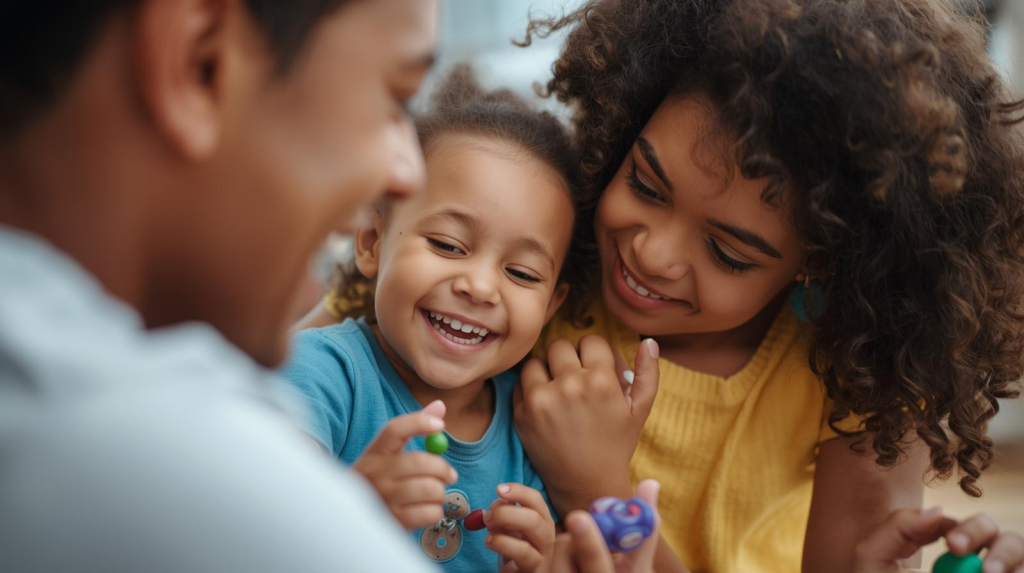Explore how embracing vulnerability in parenting fosters trust and strengthens family bonds through open communication.

In the world of parenting, vulnerability often feels like a double-edged sword. On one hand, it can be daunting to show imperfections and fears to children. On the other hand, being open can create an environment rich in trust and emotional honesty. By sharing their struggles and emotions, parents can model authenticity, encouraging their kids to do the same. This article delves into the importance of vulnerability in parenting and how it can lead to stronger family connections.
Key Takeaways
- Embracing vulnerability fosters trust and emotional honesty in parent-child relationships.
- Open communication creates safe emotional spaces for children to express themselves.
- Modeling imperfection helps children learn resilience and the value of authenticity.
Understanding Vulnerability in Parenting

Vulnerability in parenting is about being real. It’s about recognizing that no parent is perfect and that struggles are part of the journey. When parents allow themselves to be vulnerable, they create a safe space for their children to express their own fears and uncertainties. This openness can lead to deeper connections and a more trusting relationship.
For instance, a parent might share their own fears about a job loss or a health issue. By doing so, they show their child that it’s okay to feel scared and that talking about those feelings can be a source of strength. This kind of emotional honesty can help children understand that everyone faces challenges, and it’s normal to seek support.
Building Trust with Children
Trust is the foundation of any strong relationship, and parenting is no exception. When parents are open about their feelings and experiences, it encourages children to do the same. This reciprocal sharing can lead to a more profound understanding between parents and children.
One effective way to build trust is through open communication. Parents can create an environment where children feel comfortable discussing their own fears, worries, and triumphs. This might involve regular family meetings or simply checking in with kids about their day. The key is to listen actively and respond with empathy.
Open Communication in Families
Open communication is not just about talking; it’s about listening too. Parents should strive to create a dialogue where children feel heard and validated. This means setting aside distractions, making eye contact, and showing genuine interest in what the child has to say.
For example, if a child is struggling with a friendship issue at school, a parent can ask open-ended questions like, “How did that make you feel?” or “What do you think you might do about it?” This encourages children to articulate their feelings and thoughts, reinforcing the idea that their emotions are valid and important.
Sharing Fears with Kids
Sharing fears with children can be a powerful tool in building trust. It shows that parents are human and that it’s okay to be vulnerable. This practice can help demystify adult concerns and make them more relatable to children.
When parents share their fears, it can also open the door for children to express their own. For instance, if a parent talks about being nervous before a big presentation at work, a child might feel more comfortable sharing their anxiety about an upcoming test. This mutual sharing can strengthen the bond between parent and child.
Emotional Honesty in Parenting
Emotional honesty is about being truthful with oneself and others about feelings. It’s essential for parents to model this behavior, as children often learn by example. When parents express their emotions openly, it teaches children that it’s okay to feel a range of emotions, from joy to sadness.
For example, if a parent is feeling overwhelmed, they might say, “I’m feeling a bit stressed today, but I’m working on it.” This simple acknowledgment can help children understand that it’s normal to have tough days and that seeking help is a sign of strength.
Parenting with Transparency
Credits: Frank Dixon
Transparency in parenting involves being open about decisions and the reasoning behind them. This can help children understand the complexities of life and the importance of honesty. When parents explain their choices, it fosters a sense of respect and trust.
For instance, if a family is facing financial difficulties, a parent might explain the situation to their children in an age-appropriate way. This not only helps children understand the reality of the situation but also teaches them about responsibility and resilience.
Showing Imperfection to Children
No one is perfect, and parents are no exception. Showing imperfections can be a powerful way to connect with children. It teaches them that mistakes are part of life and that everyone has flaws.
For example, if a parent makes a mistake, they might say, “I messed up, and I’m sorry. I’ll try to do better next time.” This kind of honesty can help children learn to take responsibility for their actions and understand that growth comes from acknowledging one’s shortcomings.
Trust-Building Parenting Practices
There are several practices parents can adopt to build trust with their children. These practices revolve around vulnerability, open communication, and emotional honesty. Here are a few strategies:
- Model Emotional Openness: Share your feelings and experiences with your children. Let them see that it’s okay to express emotions.
- Create Safe Emotional Spaces: Encourage children to talk about their feelings without fear of judgment. Make it clear that their emotions are valid.
- Be Consistent and Reliable: Trust is built over time, so it’s essential to be consistent in your actions and words. Follow through on promises and be there for your children when they need you.
- Encourage Child Trust: Let children know that they can trust you with their thoughts and feelings. This can be reinforced by listening without interrupting and validating their emotions.
- Rebuild Trust After Mistakes: If a parent makes a mistake, it’s crucial to acknowledge it and work on rebuilding trust. This might involve having an open conversation about what happened and how to move forward.
Strengthening Family Bonds
Vulnerability in parenting can lead to stronger family bonds. When parents are open about their struggles and emotions, it creates an environment where children feel safe to express themselves. This mutual sharing fosters a deeper connection between family members.
For example, a family might have a tradition of sharing one thing they’re grateful for and one challenge they faced during the week. This practice not only encourages open communication but also strengthens the family unit.
Collaborative Parenting Approach
A collaborative approach to parenting involves working together as a family to navigate challenges. This might include setting family goals or discussing how to handle difficult situations. By involving children in the decision-making process, parents can foster a sense of ownership and responsibility.
For instance, if a family is planning a vacation, parents might ask for input from their children about where to go or what activities to do. This collaboration not only builds trust but also teaches children the value of teamwork and compromise.
Respect and Trust in Parenting
Respect and trust go hand in hand in parenting. When parents show respect for their children’s feelings and opinions, it fosters an environment of trust. This can be achieved through active listening, validating emotions, and encouraging open dialogue.
For example, if a child expresses a desire to try a new hobby, a parent might say, “That sounds interesting! Let’s explore it together.” This response shows respect for the child’s interests and encourages them to pursue their passions.
Conclusion
Parenting vulnerability is not about exposing every fear or flaw; it’s about creating an environment where emotional honesty thrives. By being open and authentic, parents can build trust and strengthen family bonds. This approach not only benefits the parent-child relationship but also fosters resilience and emotional intelligence in children. Embracing vulnerability might feel uncomfortable at first, but the rewards of deeper connections and trust are well worth the effort.
So, take a step back, reflect on your own experiences, and consider how you can incorporate vulnerability into your parenting style. It might just lead to the kind of open and trusting relationship you’ve always dreamed of.
FAQ
Isn’t showing vulnerability to my kids a sign of weakness?
Not at all. Vulnerability is actually a sign of strength. By being open about your feelings, you’re teaching your children that it’s normal to have emotions and that talking about them is healthy. This builds trust and shows them how to handle life’s challenges with honesty.
How much should I share with my kids about my struggles?
It’s about balance. Share in an age-appropriate way—enough to show that you’re human and face challenges too, but without overwhelming them with adult worries. For example, instead of going into financial stress details, you might say: “We’re being more careful with money right now, but we’re working through it together.”
What if I cry in front of my children?
Crying in front of your kids is not a bad thing—it shows them that emotions are normal and safe to express. If it happens, explain simply: “I’m feeling sad right now, but I’ll be okay.” This reassures them while modeling healthy emotional expression.
How do I know if I’m oversharing with my kids?
If your sharing shifts the emotional burden onto your child or makes them feel responsible for your feelings, it’s too much. Keep the focus on honesty without asking them to fix adult problems. A good guideline: share feelings, not fears that a child can’t control.
What if my child doesn’t open up even when I try to be vulnerable?
Some kids need more time. Keep modeling openness, show them they are safe to share, and respect their pace. Small steps—like asking open-ended questions or checking in about their day—can slowly build their trust.
Can admitting my mistakes really help my child?
Yes. Saying “I messed up, I’m sorry” teaches your child that mistakes are part of life and that apologizing is a sign of responsibility, not weakness. It encourages them to own their actions too.
How can I create a safe space for my child to talk about their feelings?
Give them your full attention, avoid judgment, and validate their emotions. Simple phrases like “I hear you” or “That must have felt tough” show that their feelings matter. Consistency over time builds emotional safety.
References
- https://www.matterfamilyoffice.com/blog/the-power-of-effective-transparency/
- https://loriwildenberg.com/2016/01/18/what-a-transparent-parent-looks-like/

